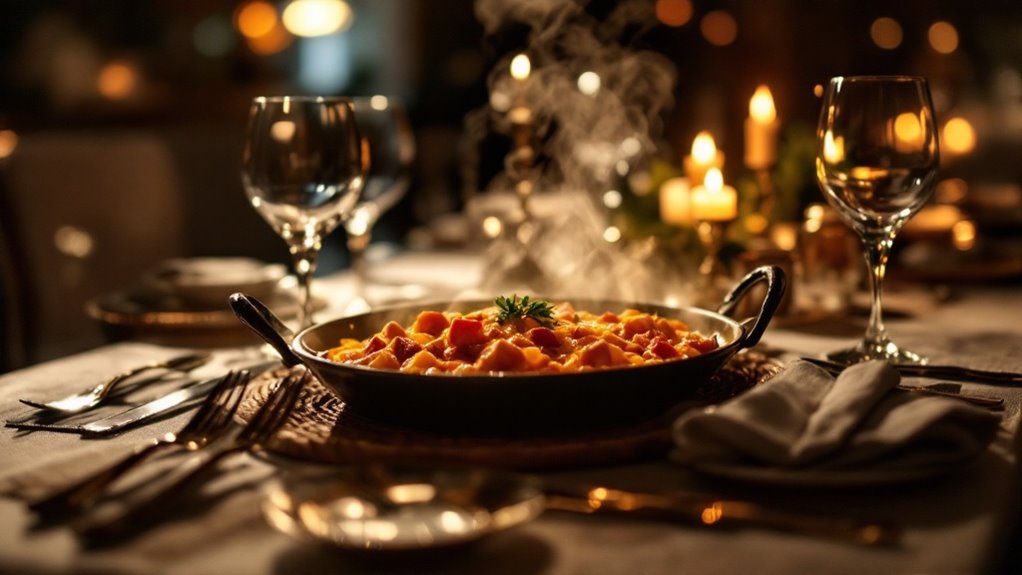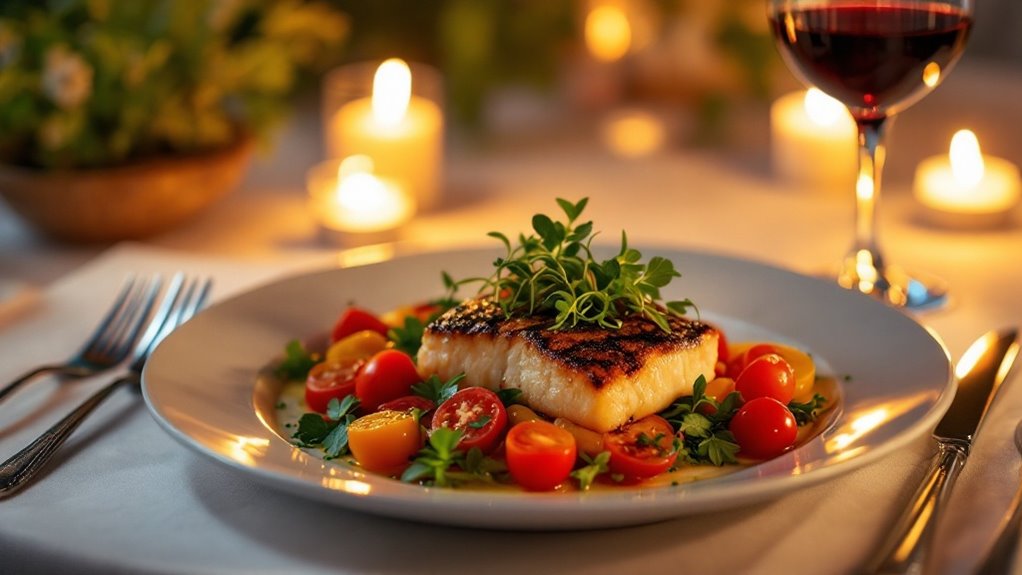When you write about an unforgettable meal, you’ll want to go beyond just listing ingredients or describing flavors. Instead, engage your audience by weaving a narrative that captures the entire dining experience. Consider how the ambiance, the interplay of textures, and the story behind the dish all contribute to its memorability.
Have you ever thought about the cultural significance or the chef’s personal journey that influences each bite? By exploring these elements, you give your readers a taste of something genuinely special, leaving them curious to uncover more about how meals become lasting memories.
Engaging the Senses
When it comes to engaging the senses in your writing, submerge yourself in the world of vivid and sensory language that authentically captures the essence of the meal. Visualize yourself on a delightful journey of sensory exploration, where each bite reveals a treasure chest of taste memories. Instead of settling for vague terms like “delicious,” plunge into specifics. Describe how that rich chocolate flavor melts in your mouth, wrapping your senses in warmth and nostalgia.
To genuinely captivate, employ metaphors and similes; perhaps the sauce is as spicy as a volcano erupting. Use all five senses to paint the picture. Envision the sight of a black forest cake, its whipped cream and cherries offering a visual feast. Hear the steak sizzle, its sound a prelude to the savory delight.
Describe the velvety texture that’s like a hug from a dear friend, comforting and familiar. Let the aroma of freshly baked bread drift through your words, like the gentle flow of a stream. Sensory language is crucial because it captures the essence of the culinary experience, transforming a simple meal description into a memorable narrative.
Through sensory exploration, you’re not just telling a story about food; you’re crafting an experience that resonates with emotions, inviting readers to savor every word.
Crafting a Narrative
Crafting a mesmerizing narrative about an unforgettable meal often begins with weaving personal anecdotes into the fabric of your story. By sharing your own experiences and memories tied to the meal, you’re not just recounting a menu; you’re inviting readers into a moment that resonated with you. Use narrative techniques to bring your tale to life—describe the setting with vivid details, painting a scene with the atmosphere, sounds, and smells. This makes the reader feel like they’re right there with you.
Food writing centers on sensory details to evoke memories and emotions, aiming to transport readers to a specific time and place through vivid descriptions. Don’t forget to add layers by highlighting cultural or historical context. Maybe the dish is Grandma’s secret recipe, passed down through generations, or perhaps it’s a modern twist on a traditional favorite. Describe the people involved, too—their laughter, conversations, and how their presence shaped the experience.
Incorporate literary devices like metaphors and similes to create vivid imagery, comparing the meal to something familiar yet evocative. Add a sprinkle of humor with hyperboles or unique portmanteaus for flavor. Keep your language lively with dynamic verbs and a few powerful adjectives. The result? A narrative that’s as unforgettable as the meal itself.
Building Urgency

Although crafting a compelling narrative can captivate readers, building urgency guarantees they stay engaged and take action. Picture you’re at a restaurant with an exclusive dish that’s only available for a limited time. You don’t want to miss out, right? By using time-sensitive offers, like “today only” or “last time,” you create that same urgency for your readers. Sprinkle in words like “hurry” or “act now” to keep the pace lively and prompt immediate action. It’s like a friendly nudge, reminding them not to delay.
Highlighting scarcity with phrases like “limited seats” or “while supplies last” can enhance demand. Let your audience know about seasonal offerings or unique local collaborations, making them feel like they’re part of an exclusive club. A little FOMO, or fear of missing out, never hurt anyone—mention that others are also buzzing about these limited-time deals. Clear call-to-action phrases are essential to ensure readers know exactly what steps to take next, preventing any confusion and enhancing the effectiveness of your urgency strategy.
Visual elements, such as countdown timers or high-quality images, can further amplify urgency. And don’t forget those dynamic CTAs—phrases like “order now” or “sign up today” can make all the difference. By integrating urgency into your marketing strategy, you make certain readers can’t resist taking immediate action.
Spotlight on Ingredients
In the world of unforgettable meals, ingredients are the unsung heroes that transform ordinary dishes into culinary masterpieces. Envision the journey your taste buds initiate when you skillfully blend quinoa and black beans, creating a protein-packed base. Ingredient sourcing plays an essential role here, as fresh bell peppers and spinach elevate the dish with their lively colors and crisp textures. It’s like assembling a colorful orchestra, each note harmonizing to create a symphony of flavors.
Now, let’s explore flavor profiles. Picture the zing of lemon zest brightening a simple soup or the savory depth that Parmesan cheese rinds add to a hearty stew. These secret ingredients are like the plot twists in a good novel—they surprise and delight, leaving you craving more. And don’t forget the dependable duo, garlic and onion, which can transform any bland meal into a comforting classic. Fresh herbs can enhance flavor profiles significantly, adding a new dimension to your dishes and making every bite memorable.
Even freezer staples like veggie burgers and organic lean ground turkey have their place in creating memorable meals. Toss in some zucchini or avocado for a fresh twist, and you’re on your way to a delightful culinary adventure. So next time you’re in the kitchen, remember that your choice of ingredients can make all the difference.
Cultural and Historical Insights

Embedded within every memorable meal is a rich fabric of cultural and historical insights that give food its deeper meaning. When you dig into your favorite dish, you’re not just enjoying flavors—you’re experiencing food symbolism and culinary heritage that tie you to a larger story.
Food serves as a bridge to personal and family history, evoking nostalgia and comfort, especially when you’re miles away from home. Recipes passed down through generations connect you with your ancestors, and for many immigrants, they carry a piece of their homeland, preserving an essential part of their identity.
Think about how traditional recipes act as time capsules, preserving cultural habits and history. Take lobster, for instance—it once symbolized poverty but now graces the tables of the elite. Or consider how food reflects a region’s landscape, like soybeans in East Asia, perfectly suited to the environment.
Food can even mark historical events, like Haiti’s Joumou soup, a symbol of freedom. And remember, culinary exchanges have shaped unique identities, such as Filipino cuisine’s blend of Spanish, Chinese, and American influences. Notably, UNESCO’s recognition of culinary traditions underscores the global significance of preserving food heritage and celebrating diversity. So, when you savor a meal, you’re tasting a slice of history, culture, and identity.
Enhancing the Atmosphere
To craft an unforgettable dining experience, the atmosphere plays as essential a role as the food itself. Lighting techniques are your first step. Envision a morning filled with bright, energetic lights to kickstart the day, then evolving to soft, warm lights as evening falls, creating a cozy, intimate vibe. You might even consider unique lighting elements, like oil lamp candles, for that extra romantic touch.
Next, let’s talk soundscapes ambiance. Noise levels can make or break a meal, so managing them is key. Use sound panels or noise-reducing linens to keep things pleasant. Music is your secret weapon—choose tunes that fit your theme and adjust playlists as the day progresses. The right music can serve as a white noise barrier, enhancing mood and conversation privacy.
Decor is the icing on the cake. Colors and decor should mirror your restaurant’s theme. Warm tones create an appetizing ambiance, while earthy tones suit natural themes. The combination of booths and tables maximizes space utilization, providing comfort and privacy for all patrons. Add personality with on-theme decor, like accent walls or colorful napkins. And don’t forget the plants and textiles—they add warmth and texture, ensuring your restaurant feels inviting and well-thought-out. Voilà, you’ve set the stage for a memorable meal!
Elevating the Experience

While a meal’s atmosphere sets the stage, it’s the personalized and engaging elements that genuinely elevate the dining experience. Envision walking into a restaurant where the server greets you by name, already aware of your favorite wine from a previous visit. This personal connection instantly makes you feel valued. Servers that can navigate the menu with ease, suggesting pairings and addressing dietary needs without a hitch, add another layer of sophistication. It’s like having a culinary guide at your table, ensuring your experience is bespoke.
Now, let’s spice things up with interactive elements. Visualize being at a DIY cocktail station, mixing your own concoction, or sampling wines that complement your meal. These little interactions don’t just enhance your enjoyment; they make the meal memorable. And who wouldn’t appreciate the efficiency of ordering and paying with a handheld device?
It’s the perfect blend of convenience and novelty. Handheld technology streamlines order-taking and payment, reducing table turn time and enhancing operational efficiency.
Incorporating these elements turns a meal into an event. With every detail, from the dish’s artistic presentation to the thoughtful use of technology, you’re not just eating; you’re experiencing. It’s these moments that transform dining into a cherished memory.
Wrapping up
Think of writing about unforgettable meals as weaving a rich fabric, where each thread represents a sensory detail, a personal touch, or a cultural nugget. You’re not just listing ingredients or critiquing taste; you’re inviting readers to join you at the table. By engaging the senses and creating a narrative, you’re transforming a meal into a memory. So, grab your pen—or keyboard—and start crafting stories that linger, much like the perfect dessert.